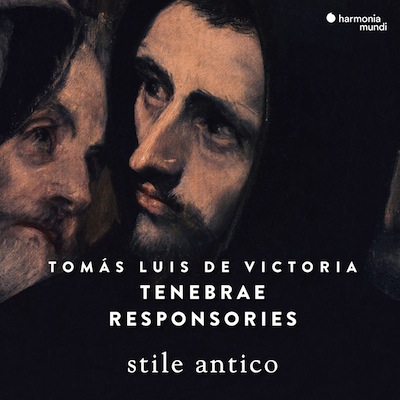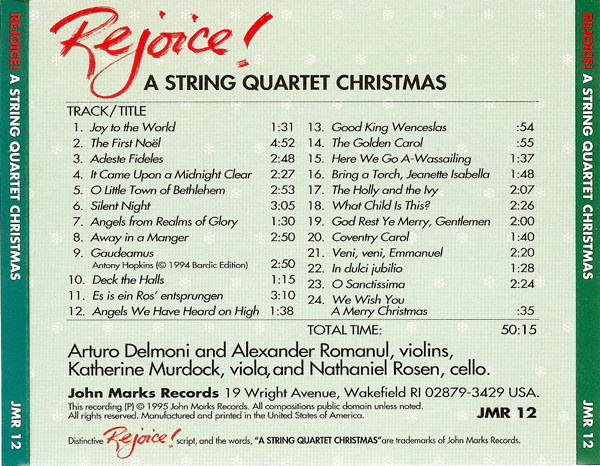
Month: March 2018
Stile Antico: De Victoria, Tenebrae Responsories for Holy Week

Stile Antico:
Tomás Luis de Victoria, Tenebrae Responsories for Holy Week
CD Harmonia Mundi HMM 902272
Downloads (24-bit/88kHz AIFF, ALAC, FLAC, and WAV stereo) available from HDTracks.
Streaming available from Tidal and Apple Music.
Recorded at All Hallows’ Church, Gospel Oak (North London) England, February 13-17, 2017. Robina G. Young, producer; Brad Michel, engineer.
The British early-music group that calls itself “Stile Antico” once again proves that they are, without doubt, one of the most impressive vocal ensembles before the public today. I Imagine that their group name just might be a bit of an insider’s joke—stile antico is a musical term used (from the early 1600s on) to characterize the continued creation of new but historically-conscious “old style” music.
The composers of stile antico music declined to embrace the emerging Baroque stylistic trends of increasingly elaborate ornamentation and more complex (and freer) counterpoint. Stile antico composers regarded the works of older composers (especially Palestrina) as ideals that could not be surpassed—a position that was still being put forward (believe it or not) even as late as the 1870s (at least in the realm of sacred music)… .
The group Stile Antico’s “Unique Selling Proposition” is that they work without a conductor or music director, in this regard being more like a chamber-music instrumental ensemble than an orchestra. While this might seem a very daunting prospect, I think that with so much of the repertory being four-part scores (two high voices and two low voices), hashing things out should be no more difficult than, say, when a string quartet’s members decide among themselves how a movement (such as the slow movement of Beethoven’s op. 127) should be played. (Irony alert.)
I was rather agog at Stile Antico’s 2006 début SACD Music for Compline when I wrote about it for Stereophile magazine, and they have continued at that high level for more than 10 years. Their articulation, phrasing, and ensemble work are among the best; but what really sets them apart is the lush richness of their vocal sound. Arkivmusic.com has Stile Antico’s Music for Compline on offer at $9.99, which I gather is a 10th-anniversary non-SACD CD reissue. That one’s a no-brainer. Just buy it. The o.o.p. SACD version is available from third-party sellers on Amazon, at prices ranging from market-correct to delusional. (But I did tell Stereophile‘s readers to just buy that, more than 10 years ago.)
After the jump: a making-of video of Stile Antico’s Tenebrae Responsories, some background and commentary, and a few sound bytes. Continue Reading →
A Classical-Music Record Producer Remembers…
 (The copyright date is 1995, despite the release date having been late 1994.)
(The copyright date is 1995, despite the release date having been late 1994.)
Last week marked Arturo Delmoni’s 70th birthday. We met in 1980 through mutual friends, during the summer music festival at Rhode Island College. At the time, I was both a budding audiophile (the term was not much in use back then) and also, since my junior-high-school days, an audio-video nerd. Years before, an uncle had given me an open-reel tape recorder he was no longer using. I recorded my junior-high-school chorus in lamentable stuff such as, “If We Could Talk to the Animals” from Doctor Doolittle. (That was a 1967 film that Rex Harrison most likely did not have to live very long after, in order to regret muchly. Sigh.)
Customers of my parents’ delicatessen-café included the couple who ran the independent record label SQN (or Sine Qua Non). I chatted them up about their possibly releasing a recording to be funded and owned by Arturo Delmoni and licensed to them. The one good thing that SQN did for me (well, over and above giving me an “education” in how the music business really works) was to introduce me to engineer David Hancock.
The SQN folks recommended David Hancock because he had not yet invested in the latest digital-recording technology, and therefore his rates were lower than those of the top guys. David had invested, however, in a spanking-new Studer A80 analog tape machine, set up to use half-inch two-track analog tape running at 30 inches per second. Whew.
Now, class, a “thought experiment.”
How many people today would pay over $300 for a sealed-copy LP of Songs My Mother Taught Me, if it had been recorded using early-generation digital technology??? (It is said, that to state some propositions is to refute them.) David Hancock was also a fan of Charles Fisher’s C35 Cambridge microphones, which were, in essence, improved RCA model 44 ribbon microphones with an active proximity-effect-compensation circuit. Those were the microphones David had used on his legendary 1967 recording of Donald Johanos and the Dallas Symphony in Rachmaninoff’s Symphonic Dances.
Dawn on the Mississippi River (New Orleans, March 5, 2018)

Photograph © 2018 John Marks
I don’t have a “Bucket List.”
That said, if I did, watching the sun rise over the Mississippi River in New Orleans would be a good thing to add to such a list. For some reason, the view made me think of Mussorgsky’s “Dawn on the Moskva River,” from his rarely-performed opera Khovanshchina.
(The link is to a very evocative YouTube slideshow over a USSR Symphony Orchestra performance with Evgeny Svetlanov, conductor.)
# # #
Vox Luminis: “Mille regretz” (attr. Josquin des Prez, c. 1450/1455 – 1521)
If humans were like amoebas—and multiplied by dividing—nobody (with the potential exception of Sarah McLachlan) would write songs about lost love. The song sub-genre “Baby, This Makes Me So Blue” predates the 1950s… by about 500 years. The chanson “Mille regretz” (“A Thousand Regrets”) is usually attributed to Josquin des Prez, who flourished in the late 1400s and early 1500s–the High Renaissance. Josquin was his name, and polyphony was his game.
“Mille regretz” was reputedly the favorite song of King Charles I of Spain, who in due course became Holy Roman Emperor Charles V. Charles’ consolidated holdings stretched from Peru to Bohemia, totaling about 1.5 million square miles. His was the first empire about which it was said, the sun never set upon it. But even he got the blues; and when he did, he turned to music. Continue Reading →


